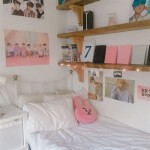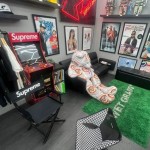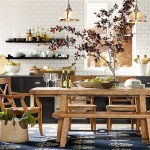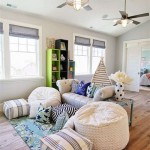Decorating Living Room Side Tables: Functionality Meets Style
Living room side tables are often overlooked, yet they play a vital role in both the functionality and aesthetic appeal of a living space. These small surfaces offer a convenient place to rest drinks, books, or remote controls, while also providing an opportunity to express personal style. Effectively decorating a side table involves striking a balance between practicality and visual harmony, ensuring the table enhances the overall ambiance of the room without becoming cluttered or visually distracting.
The selection of items used to decorate a side table should align with the room’s overall design scheme. Whether the style is modern, traditional, minimalist, or eclectic, the chosen accessories should complement the existing furniture, colors, and textures. Cohesion in design creates a unified and aesthetically pleasing environment.
Considering Practicality: The Foundation of Side Table Decor
The initial step in decorating a side table is to assess its practical function. Consider how the table will be used on a daily basis. Will it primarily serve as a resting place for beverages and snacks while watching television? Or will it be a spot for reading and relaxing? Understanding the table’s primary function helps determine the types of items that should be placed on it.
If the table is intended for practical use, items such as coasters, a small tray, and a remote control holder are essential. Coasters protect the table’s surface from water rings and heat damage, while a tray provides a designated area for snacks or drinks, preventing spills and keeping the surface clean. A remote control holder keeps remotes organized and easily accessible, preventing them from getting lost between cushions or cluttering the table.
A lamp is another practical addition to a side table, particularly if the table is located beside a sofa or armchair intended for reading. A well-chosen lamp provides ample lighting for reading or other activities, while also adding a decorative element to the table. The lamp’s style should complement the room’s overall design aesthetic, and its size should be proportionate to the size of the table.
Beyond these functional items, consider adding a small, decorative box or basket to store smaller items such as reading glasses, charging cables, or notepads. This helps to keep the table surface clutter-free while providing easy access to essential items.
Achieving Visual Balance: The Art of Arrangement
Once the practical needs are addressed, the next step is to arrange the items on the side table in a visually appealing manner. Balance is key to creating a harmonious and uncluttered look. Avoid overcrowding the table with too many items, and strive for a mix of heights, shapes, and textures.
A common approach to achieving visual balance is to use the "rule of three." This principle suggests that items arranged in odd numbers are generally more visually appealing than items arranged in even numbers. For example, a lamp, a stack of books, and a small decorative object can create a balanced and interesting arrangement.
Varying the heights of the items on the table is also important. A tall lamp can be balanced by a shorter stack of books and a low-lying decorative object. This creates visual interest and prevents the table from appearing flat or monotonous. Consider using books as risers to elevate smaller objects and add height to the arrangement.
Texture plays a significant role in creating visual interest. Combine items with different textures to add depth and dimension to the arrangement. For example, a smooth ceramic vase can be paired with a textured woven basket or a stack of books with a leather cover. This contrast in textures adds tactile appeal and prevents the arrangement from feeling sterile or predictable.
Color is another important consideration. Choose items that complement the room’s color palette. You can either opt for a monochromatic scheme, using variations of the same color, or a complementary scheme, using colors opposite each other on the color wheel. A pop of color can add visual interest to a neutral room, while a muted color palette can create a calming and serene atmosphere.
Incorporating Personal Style: Adding Meaning and Character
After addressing the practicality and visual balance of the side table arrangement, the final step is to incorporate personal style. This is where you can add items that reflect your interests, hobbies, and personality. These personal touches can transform a generic side table into a unique and meaningful focal point in the living room.
Photographs are a great way to personalize a side table. Displaying framed photos of loved ones, travels, or special events adds a personal touch and creates a sense of warmth and nostalgia. Choose frames that complement the room’s overall design aesthetic and arrange them in a visually appealing manner.
Collectibles and souvenirs can also be used to personalize a side table. Displaying a small collection of favorite objects, such as shells, stones, or vintage finds, adds character and tells a story. Arrange these items thoughtfully, considering their size, shape, and color.
Books are not only functional but also decorative. Displaying a stack of favorite books adds intellectual appeal and reflects your interests. Choose books with visually appealing covers that complement the room’s color palette. You can also use books as risers to elevate smaller objects and add height to the arrangement.
Plants and flowers bring life and vibrancy to a side table. A small potted plant or a vase of fresh flowers can add a touch of nature and brighten up the space. Choose plants that are appropriate for the lighting conditions in the room and arrange them in a visually appealing container.
Art objects, such as sculptures or small paintings, can also be used to personalize a side table. Choose art that resonates with you and complements the room’s overall design aesthetic. Consider the size and scale of the art object in relation to the size of the table.
Ultimately, decorating a living room side table is about creating a space that is both functional and visually appealing. By considering practicality, achieving visual balance, and incorporating personal style, it is possible to transform a simple side table into a stylish and meaningful addition to the living room.
The careful selection and arrangement of items on a side table can elevate the overall aesthetic of a living room, adding a touch of personality and sophistication. The key is to maintain a balance between functionality and style, ensuring that the table serves its practical purpose while also enhancing the room's overall decor.
Remember to regularly reassess the arrangement of the side table. Styles and needs evolve, so don't be afraid to swap out items or rearrange the display to keep it fresh and relevant to the current aesthetic of the living room. A well-decorated side table is an ever-evolving reflection of personal taste and lifestyle.

How To Style An End Table Like A Pro Stonegable

Stylish Side Table Decor That Pulls A Room Together

Side Tables And End A Guide To Decorating With Them

Home Decor 101 How To Decorate End Tables The Turquoise

Home Decor 101 How To Decorate End Tables The Turquoise

Home Decor 101 How To Decorate End Tables The Turquoise

9 Gorgeous Accent Table Décor Ideas Living Spaces

Home Decor 101 How To Decorate End Tables The Turquoise

How To Style An End Table Like A Pro Stonegable

19 Creative Coffee Table Alternatives Designers Love







